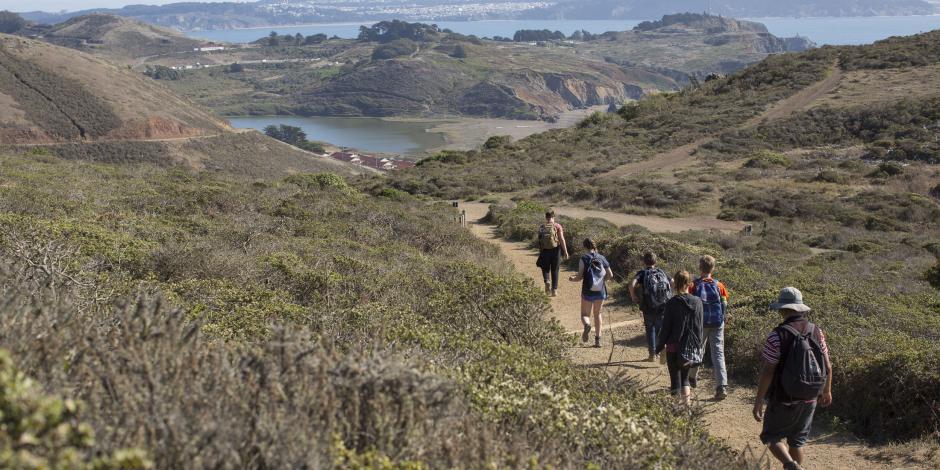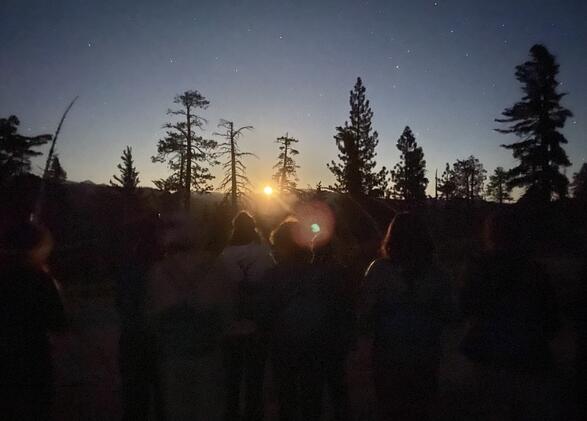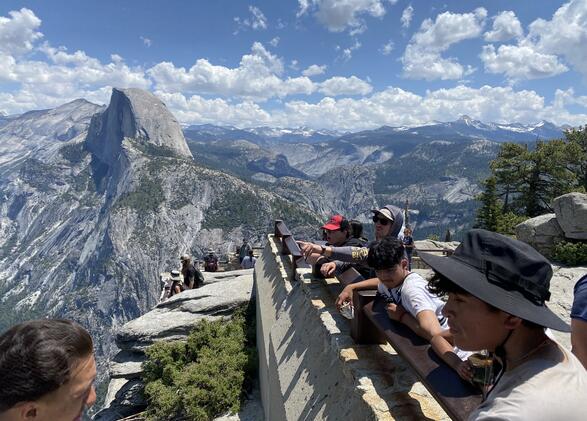Hans Cole and the Nonprofit for Profit

What am I most excited about? Well, we just revamped our climate strategy about two months ago, and we launched it on our website. While our teams have been working hard to reduce our carbon footprint for years, we said we're still not doing enough on climate. We're just not. And we haven't been vocal enough. We haven't been forward enough on it. We have got to do more.”
Hans Cole’s answer makes him sound as though he is chief of staff for an elected official or manages a nonprofit organization — the urgency around climate change, the focus on advocacy, the way he talks about his job. Hans worked as an educator for NatureBridge (then Headlands Institute) from 1996 to 1999 and managed educational programming for the Jane Goodall Institute for seven years.
So what nonprofit does Hans currently run?
“I feel like in some ways — it’s funny to say — but working for Patagonia, I do feel like I’m following that path,” says Hans. “I am working for a company, but it happens to be a pretty unusual company.”
Hans Cole is Patagonia’s Head of Environmental Activism, Grants, and Campaigns, leading its strategic environmental partnerships and helping to achieve the for-profit corporation’s most important goal: to save our home planet.
Pretty unusual indeed.
What the Headlands (NatureBridge) did for me was it opened my eyes to the possibility of having a whole life devoted to working on environmental issues and environmental topics.Hans Cole
Hans came to NatureBridge from the East Coast in 1996, interning for three months before being hired as an educator.
“There were nine of us living in these old officers’ quarters that were part of the campus. It was just amazing. I think it's probably the most incredible place I've lived; it's one of the most incredible communities I've ever been a part of,” says Hans.
He spent three years working as an educator with NatureBridge, honing his teaching skills and expanding his horizons. A pre-med student, Hans hadn’t considered a full-time career in environmental education when he first moved to California.
“What the Headlands (NatureBridge) did for me was it opened my eyes to the possibility of having a whole life devoted to working on environmental issues and environmental topics,” he says.
That life of dedication to environmental issues began at NatureBridge for Hans, and it was there that, through a fateful encounter, he would find his next job.
“My whole career came from my time at the Marin Headlands and meeting Dr. Jane Goodall on the beach with a group of third graders.”
Jane Goodall was visiting NatureBridge because at the time, she was building a youth service learning organization. She had come to see one of the most renowned environmental youth education nonprofits in action.
“I just happened to be teaching that day with a few other instructors. It was me and this other instructor, Derek, who happened to be closest to the campus buildings where Jane would be. So Derek and I were designated to hang close, and whoever was closest to Jane would just make eye contact with her, and that would be the way to invite her to join our group of students.”
Jane exited one of the campus buildings, looked Hans’s way, and the rest is history.
“Dumb luck,” says Hans. “I was closer, she joined our group and we all walked out to the beach together. Within minutes she had the students captivated, doing her famous chimpanzee call. They were blown away. I was blown away.”
One of the Institute employees connected with Hans and told him to apply to a new position at Goodall’s Roots & Shoots environmental service learning program. He figured it was a great opportunity, and after receiving encouragement from his supervisors and colleagues at NatureBridge, he applied and got the job. Seven years later, he left the Jane Goodall Institute as its National Director of Outreach and Leadership to go to graduate school, and then work for Patagonia.
I would make the argument that if you're able to manage and facilitate a group of fifth graders through a week of environmental education in the midst of rain and turbulent weather, and motivate them to hike back and forth across a landscape while learning and keeping their minds open to a whole new world…I think if you can do that, you're pretty much ready to go out and lead a nonprofit. Or work for Patagonia.Hans
Now in his 14th year with Patagonia, Hans says he’s never worked for a company quite like the famous outdoor clothing retailer.
“Patagonia is a company of activists,” he says. “The company has been hiring people with that character trait in mind for years; people who have an interest not only in making great products, but also in taking a very active role in trying to protect our planet and the environment, at both a local level and a global level.”
Founded in 1973 — just two years after NatureBridge — Patagonia has become synonymous with high quality outdoor gear and a focus on the planet. It was Yvon Chouinard, Patagonia’s founder, that co-created 1% for the Planet, a global initiative wherein signatory corporations donate 1% of their total sales to environmental organizations. Patagonia is also a certified B-Corp, meaning it meets certain social and environmental sustainability requirements, and was the first company in California to become B-Corp-certified.
“That means we've changed our company charter to ensure that no matter what happens with the ownership or the management of Patagonia going forward, the company will have those values,” says Hans. “Even at that root level, we're committed.”
Thanks to the work of Hans and other Patagonia leaders and staff, the company’s ambitions have grown. The revamped climate strategy Hans mentioned at the beginning of this story has led to a clear, powerful statement of its goals. Doubling down on its aim to be carbon neutral by 2025, the new Climate Goals page begins with a headline: The Climate Crisis Is Our Business, and delves into specifics from there.
“We landed on several important focus areas, including a just energy transition, which means working with communities to push back against fossil fuels and supporting renewables; and protecting nature and carbon sinks, which is something we’ve been doing for decades at Patagonia, but now with a focus on climate,” says Hans.
The danger today for any company engaging in social and environmental advocacy is, of course, backlash. Patagonia has seen its fair share of people try to boycott or cancel the company on social media, but time and time again, the company hasn’t budged on its ethics. In 2021, Patagonia donated $1 million to fight restrictive voting measures in Georgia; in 2016, it donated 100% of its Black Friday sales to grassroots environmental groups, totaling over $10 million; and in 2017, the company joined several Native American tribes and conservation nonprofits to sue the Trump Administration over its proposed shrinking of Bears Ears National Monument and Grand Staircase-Escalante National Monument. Polarizing, perhaps, but it has never hurt the company’s sales.
“We have this great core group of customers who really know us, who get us on the environmental side and the sport side, and then we have this broader group who just know us through our products,” says Hans. “Frankly, they may or may not think of themselves as connected to our environmental views, but we have the ability to speak to them because they are connected through product, and when it comes to topics like protecting public lands, we can actually make progress there and gain traction with that broader audience.”
For everyone at the company, it goes back to that mission of saving the planet and the Climate Goals. Managing how Patagonia achieves those goals while still outfitting people with hiking boots and thermal shirts is Hans’s job, in a nutshell.
“A lot of our focus is on local groups and grassroots organizations,” he says. “Folks who inherently understand the problems that they're facing and also know the solutions, but maybe don't have the capacity or funding to bring it to life. Plus I think the grassroots level is where a lot of the best ideas for campaigns come from, too, in terms of what Patagonia ends up engaging in.”
NatureBridge is one of those grassroots organizations that receives generous support from Patagonia. For more than 20 years, Patagonia’s founders and the company have supported NatureBridge’s environmental science education, through product donations and direct support to the Armstrong Scholars program.
“We're highly aware that Patagonia alone, you know, we're not going to save the planet by ourselves, obviously. The only way to literally contribute to that mission is to engage other people; to engage other businesses to come together in coalitions and to organize and build the movement on local and global scales. And Patagonia will share anything we find useful; we're not trying to hold tight our recipe for doing this.”
Here, yet again, it sounds as if Hans is running a nonprofit. Sharing secrets? Donating all of its Black Friday sales? Not bowing to social media pressure on politically volatile topics?
Par for the course for Patagonia.
As to why Hans is so successful in this role which straddles the for-profit and nonprofit worlds so deftly?
“Honestly, it goes back to my experience in the Headlands [with NatureBridge],” he says.
“I would make the argument that if you're able to manage and facilitate a group of fifth graders through a week of environmental education in the midst of rain and turbulent weather, and motivate them to hike back and forth across a landscape while learning and keeping their minds open to a whole new world…I think if you can do that, you're pretty much ready to go out and lead a nonprofit. Or work for Patagonia.”


